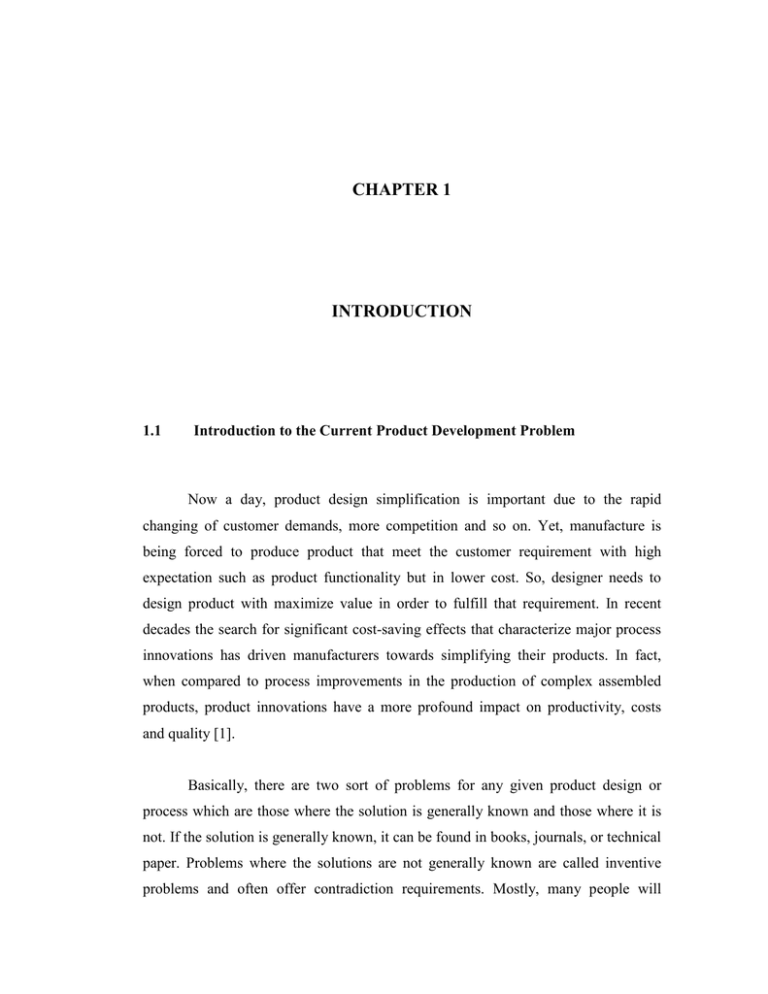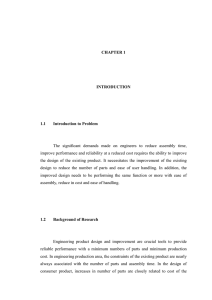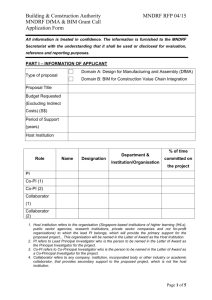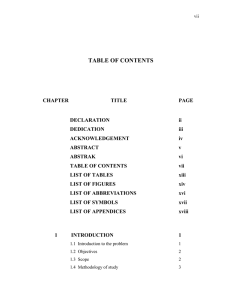Product Design Improvement: TRIZ & DFMA Methodology
advertisement

CHAPTER 1 INTRODUCTION 1.1 Introduction to the Current Product Development Problem Now a day, product design simplification is important due to the rapid changing of customer demands, more competition and so on. Yet, manufacture is being forced to produce product that meet the customer requirement with high expectation such as product functionality but in lower cost. So, designer needs to design product with maximize value in order to fulfill that requirement. In recent decades the search for significant cost-saving effects that characterize major process innovations has driven manufacturers towards simplifying their products. In fact, when compared to process improvements in the production of complex assembled products, product innovations have a more profound impact on productivity, costs and quality [1]. Basically, there are two sort of problems for any given product design or process which are those where the solution is generally known and those where it is not. If the solution is generally known, it can be found in books, journals, or technical paper. Problems where the solutions are not generally known are called inventive problems and often offer contradiction requirements. Mostly, many people will 2 choose a compromised solution, where not all of the requirements are met and those that are met, are not optimized in order to resolve contradictory requirements or conflict [2]. In this case, there are several ways to solve the problem. The use of integrated several VE tools will help to resolve conflict and generate new solutions from outside the experience. 1.2 Objective To integrate Theory of Inventive Problem Solving (TRIZ) tool, and Design for Manufacture and Assembly (DFMA) methodology in order to improve and value added the current design of consumer product 1.3 Scope The study will focus on the: i) Application of DFMA methodology to identify detailed design problems and generate remedial design solutions. ii) Application of TRIZ method to improve the value added product development. iii) Consumer product as case study – Sponge Mop 3 1.4 Methodology of Study This thesis is conducted accordingly in two parts which is Master Project 1 (MP 1) in semester 1 and Master Project 2 (MP 2) in semester 2 as shown in Figure 1.1. The flow chart showed clearly the processes of the thesis activities in order to meet the time constrain. After the project had determined, the literature review on VE, DFMA and TRIZ methodology are studied in the early stage. The studies are done by reviewing the related books, journals and articles. For a while, the consumer product for the project analysis purpose is also been selected. The selected product then is been evaluated by using DFMA methodology and from the results some improvements are proposed. However, the proposed improvement activities will be continuing also in the MP 2. It is continuously process as in the stage of evaluation the new design with using integrated VE tools, it may have some unsuitability idea. So, the others proposed improvement need to do. Lastly, the discussion and conclusion will be done after the accurate analysis result on the new design is evaluated where, the new design of integration tools is compared to the new design of DFMA methodology in terms of percentages of part count reduction and design efficiency increment. 4 Literature Review on DFMA and TRIZ Methodology Discussion of the Both Designs Figure 1.1: Flow chart of the project activities for MP 1 and MP 2. 5 1.5 Significant of Study The significant of this thesis is to prove the use of integration of VE tools will give a better result of product design in term of simplification, product cycle life, efficiency, quality, function and also product value. In this thesis, product design improvement is done by integration of TRIZ and DFMA methodology. Hopefully with the result of this study, it can give an overview to others about the advantages of using integration problem solving tool in product development and then will attract more organization to use this method for their product development purpose. The result of integration problem solving tools should achieve improvement better than single tool with the main improvement is to reduce assembly and manufacture process time and cost. However, in case the improvement in term of cost and time does not show much improvement, the others factor such as product simplification, function and life cycle should be considered. 1.6 Report Structure This thesis consists of nine chapters. Chapter 1 presents the introduction of the thesis, Product Design Improvement through TRIZ and DFMA methodology where the topic include are objective, scopes, methodology of study and significant of study of the project. The literature reviews in Chapter 2 reports on relevant previous findings that are related to the research and also the review of the related discusses topics. The detail information on the research methods and tools that will be used in the case study is explained in Chapter 3. For the Chapter 4, the data information of the product case study will be explained in details. The next chapter consists of the original data analysis of the product case study. In this Chapter 5, the DFMA Methodology is applied. The proposed improvement of the original data case 6 study then been discussed in Chapter 6. This chapter covers both of the selected design problem solving tools. The analysis of the new improvement of the product case study then discussed in Chapter 7. The discussion of the case study result is in Chapter 8, while the conclusion of the case study is concluded in Chapter 9. The time management of all activities for the MP, Product Design Improvement through VE and DfMA methodology project is shown in Gantt chart MP 1 (Appendix 1A) and Gantt chart MP 2 (Appendix 1B). 1.7 Summary Through this thesis, the objective of the project is hopefully achieved as expected which is contained the important result such as success to improve design of the product case study by applying the selected methods and also develop a product that have maximize value, convenience, suitable and easy to use by the consumer. On the other hand, this chapter is providing information about the aim for the rest of the chapter.



